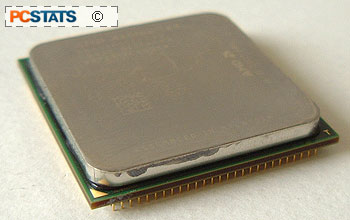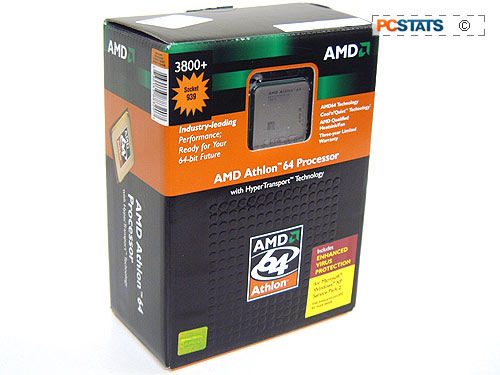AMD Athlon64 3800+ Socket 939 64-bit CPU Review
The AMD
Athlon64 3800+ processor follows in the footsteps of its popular 32/64-bit siblings, and proves itself well in the benchmarks
as we'll soon see. Built on the same 0.13
micron manufacturing process as earlier Athlon64 CPUs, the Athlon64 3800+
marks the point when AMD transitioned from a 754-pin package to 939 pins. The chip
we'll be testing out in this review is based on the 'Newcastle' core, and
runs at a very nice speed of 2.4 GHz.
The Athlon64 3800+ uses an organic FCPGA packaging as
opposed to the ceramic found on Athlon64 FX chips. From the top, the Athlon64
3800+ looks identical to the Athlon64 3200+.
On the bottom of the processor, it is simply filled with
pins, although this shouldn't be a surprise considering the amount of pins in
the new socket 939 package.
Along with the introduction of the Socket 939 Athlon64
3800+, AMD also released the
Socket 939 Athlon64 3500+ (2.2 GHz) and moved its high end Athlon64 FX-53 (2.4 GHz) over to the Socket 939 platform. Subsequent processors
have since been released for both the Athlon64 and Athlon64 FX, but the
3800+ was the first to make the transition.
With both
mainstream Athlon64 and high end Athlon64 FX processors using the
939-pin socket, and dual channel DDR memory, AMD had to figure out a new way of
differentiating them. If you remember, the main difference between Socket 754
Athlon 64 and Socket 940 Athlon64 FX was the dual-channel
memory that the
FX had.
 |
|
AMD Athlon64 3800+ Processor |
|
|
 |
| Includes: |
|
Warranty,
instructions |
| |
| |
This time around AMD has cut the L2 cache in half for Socket 939 Athlon64 CPUs. Future Athlon 64 Socket 939 chips will have 512K of
level 2 cache as compared to the Athlon64 FX's full 1MB. This is actually not as
bad as it might sound, since Athlon64 processors rely on cache less than equivalent
Pentium 4 processors due to a more efficient core design. Reducing the size of the cache should also help AMD's manufacturing yields as the silicon core has shrunk in size from 193mm2 to
144mm2.
The
enthusiasts out there will be happy to hear that Socket 939 Athlon64 processors still have access to lower
multipliers. If you're really hardcore and have the money to spend, the Athlon64
FX line is completely multiplier unlocked!
 There
are a few other changes and upgrades to the Socket 939 platform as well. The HyperTransport link between the
CPU and the motherboard has officially been upgraded from 800 MHz up to a full
1 GHz. This increases the bandwidth from 6.4GB/s
to 8GB/s!
There
are a few other changes and upgrades to the Socket 939 platform as well. The HyperTransport link between the
CPU and the motherboard has officially been upgraded from 800 MHz up to a full
1 GHz. This increases the bandwidth from 6.4GB/s
to 8GB/s!
The extra speed and bandwidth should
help get data between the CPU and the various other system components faster, increasing overall
system performance.
Of course,
with the introduction of Socket 939, Socket
940 is finished, at least in the consumer desktop market. If you're thinking about plugging
a Socket 939 processor into a Socket 940 motherboard you're going to be
disappointed. The processor will physically fit, but the two CPUs are
not pin compatible. AMD will continue on with Socket 940 only for their workstation/server based Opteron processors. Socket
754 lives on of course, but it has quickly been relegated
to the budget level platform, and AMD Sempron processor.

